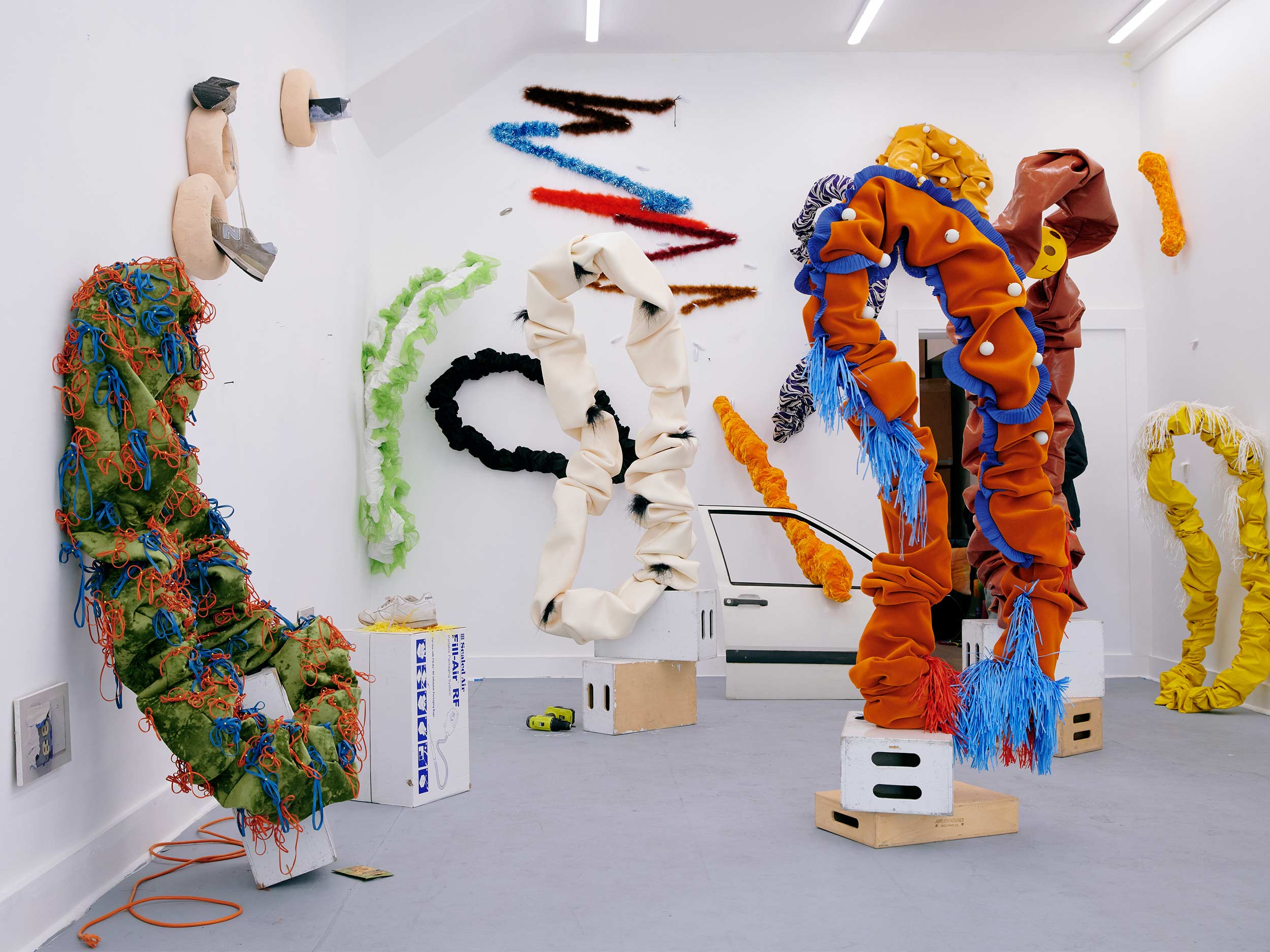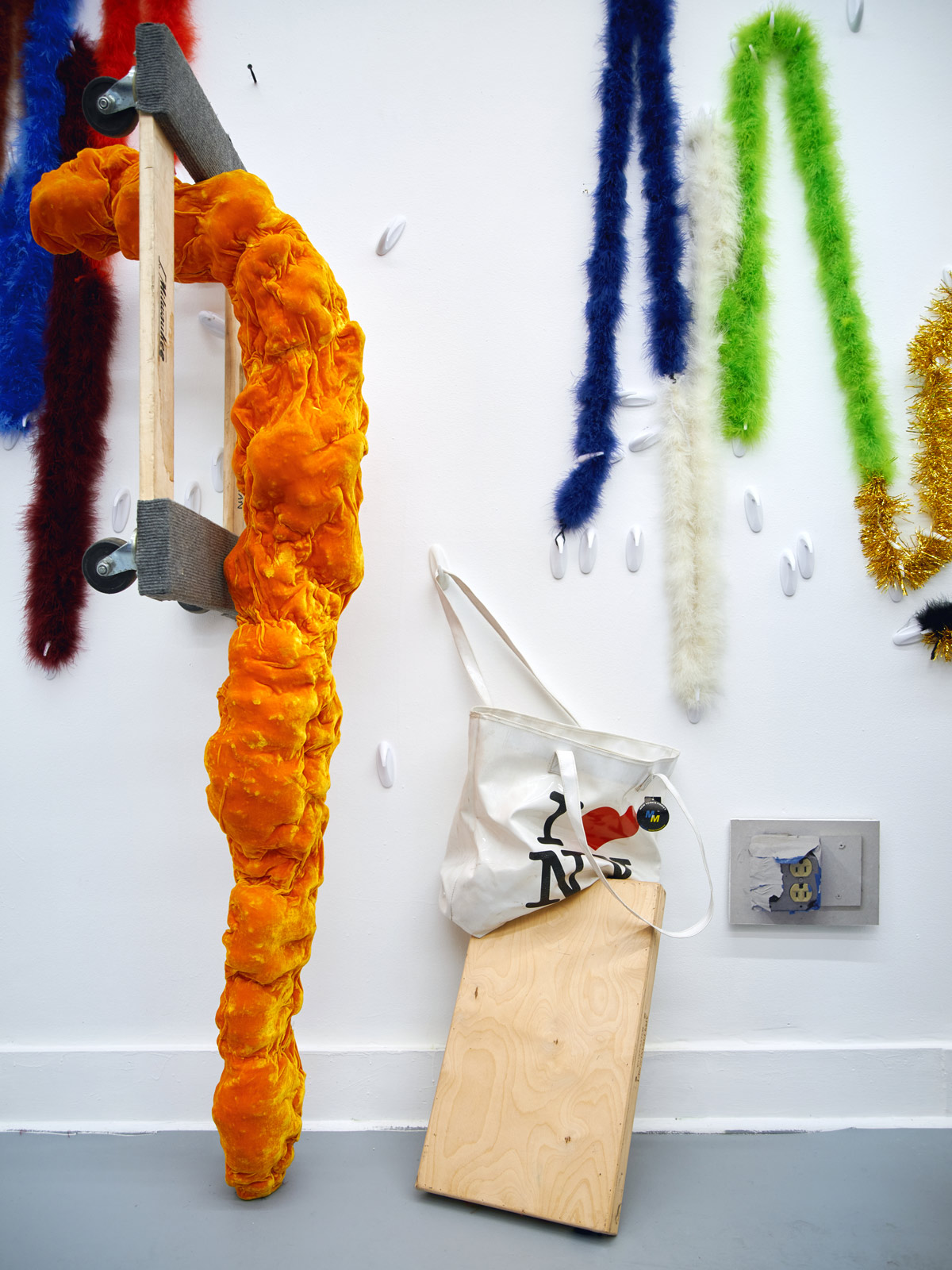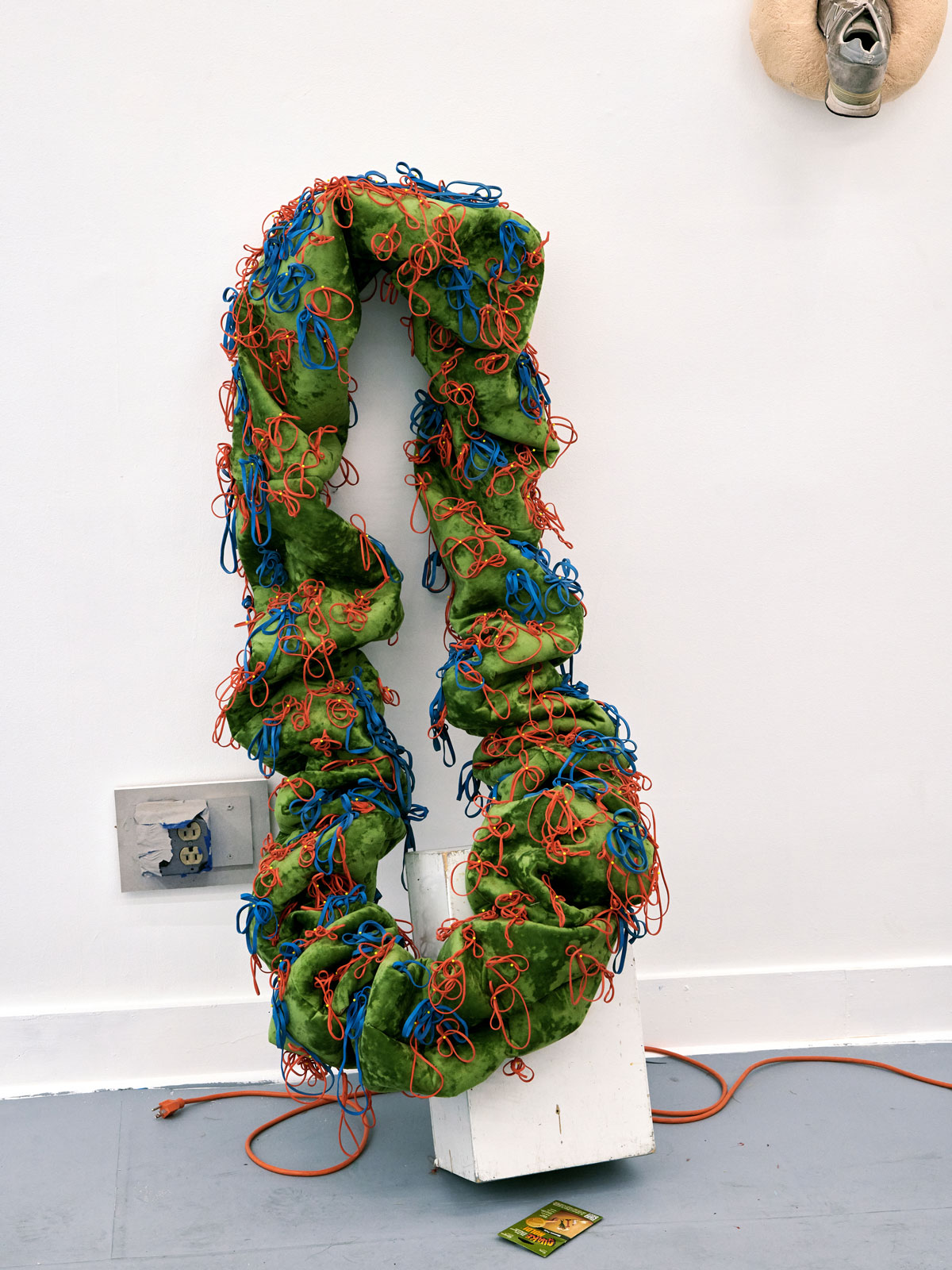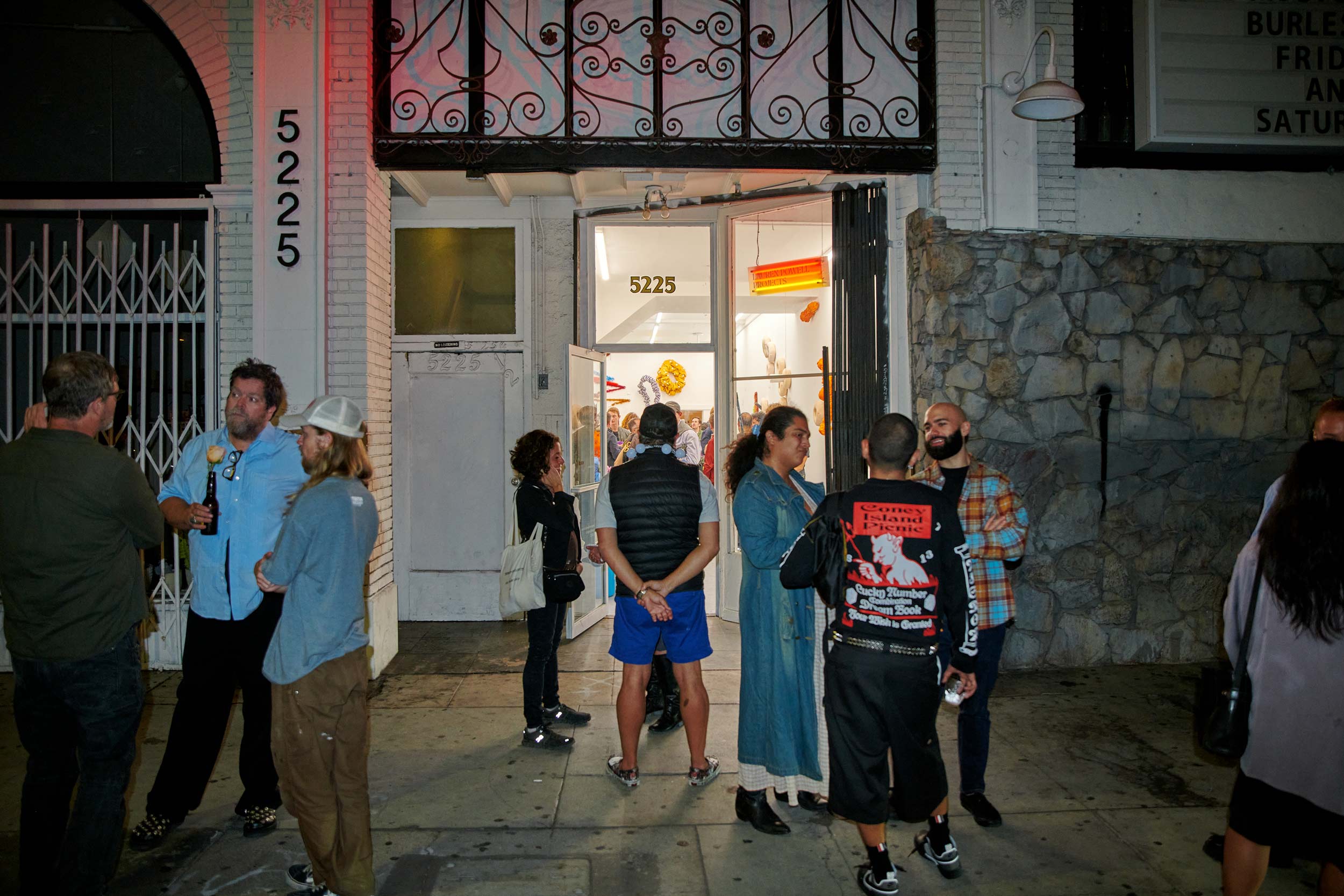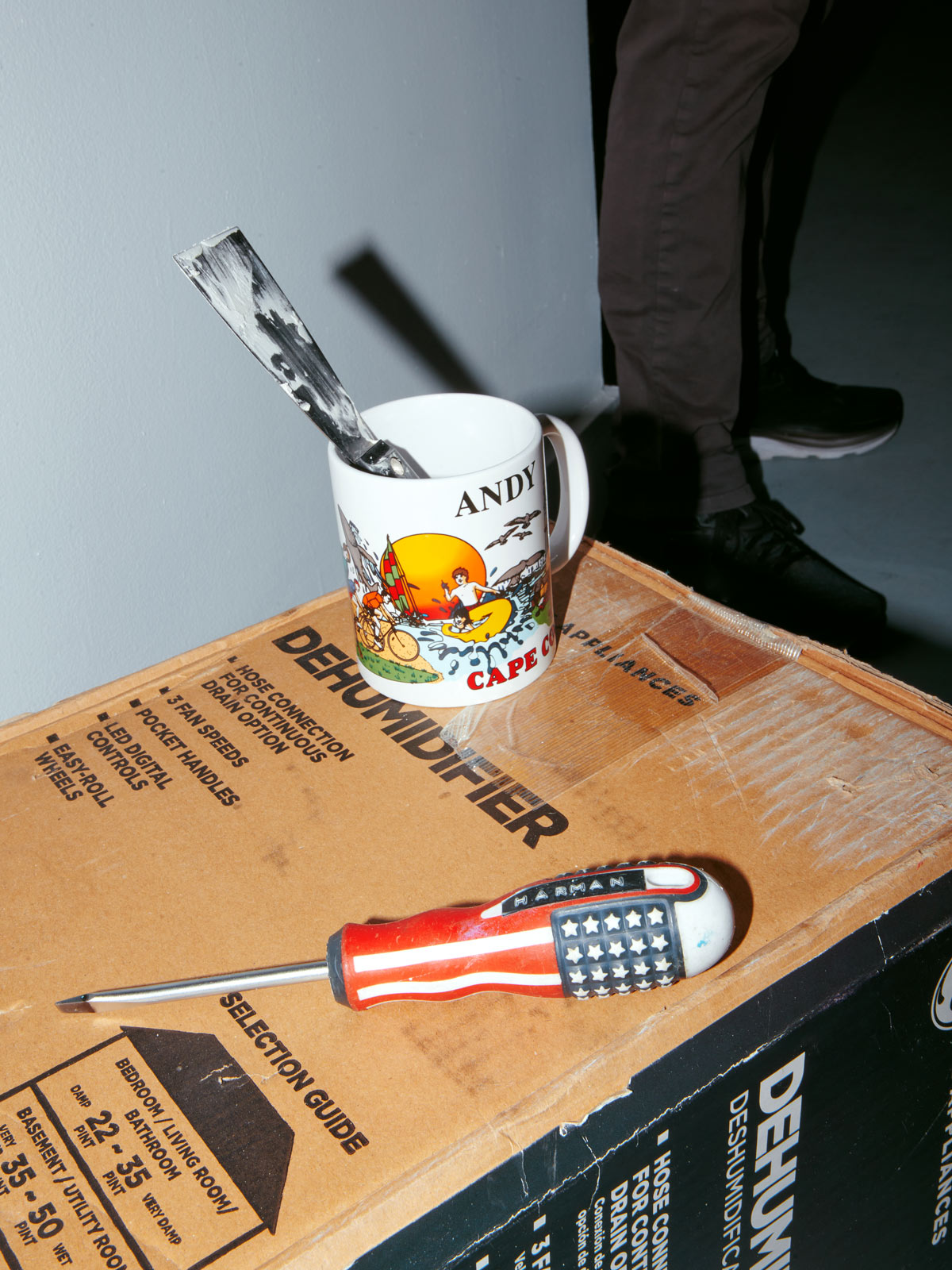Re-staging his Brooklyn studio inside a gallery space in Los Angeles, the set designer and sculptor plays with the conflict between the familiar and the peculiar
In a white-cube gallery space, it’s rare that the viewer must put in effort to tell artworks apart from their milieu. Yet in Andy Harman’s new show Leave This Like That Over There, the viewer is confronted with dusty nail holes, unwieldy concrete blocks, and a myriad of white 3M command hooks trespassing across unruly drywall patches, inviting the question: Has the exhibition opened yet, or has it already drawn to a close?
Harman has created a replica of his Brooklyn studio in the Los Angeles gallery, collapsing time and space to create a representation of his own lived experience on opposite coasts. It’s an elusive temporal gesture that cannot be comprehended visually, despite the works’ insistent, bright-colored animacy. Slouching against walls and scattered across the floor are large, irregular textiles and idiosyncratic objects. Scrunchies, embellished with tactile flourishes of fur and fringe, are swollen, slumps and ripples evident in their upholstery; velvet neon Cheeto sticks taunt their brittle crunch in haphazard, Brutalist arrangements; colored feather boas hang in zigzag formations, which Harman refers to as “drawings.” The heaping 3M command hooks act as counterparts to these wall scribbles—not only as support, but as temporal markings, highlighting the transient nature that permeates Harman’s work. “I will sometimes just remove all the boas from a drawing and just only keep the hooks,” he says. “I like to see them as a sort of history.”
Harman’s works continually recycle remnants of his past. Many of the sculptures on display are shaped by, and made with, leftover material from previous photoshoots and set work, dealing with them as lived-in and worked-with objects of familiarity. Having worked in the industry as a set designer, Harman likes to poke fun at the myth of fashion. For him, toying with taste is a full-time job: no pretty things need to stay at a distance for fear of wrinkles.
Somewhere between the show’s elusory beginning and ending, the artist sits down with Document to discuss his ongoing project, explaining in detail his whimsical yet sincere tactics to “make things not make sense.”
Yuki Xu: I’d like to start off by asking, do you consider yourself a sculptor? If that word doesn’t fit exactly, is there another one you’d prefer?
Andy Harman: I would say that fits the best, but it’s always up for discussion.
Yuki: Could you explain your decision in hanging and displaying your works in a non-linear, seemingly non-methodical manner? The utilization of 3M command hooks… Is that part of the work, part of the installment process, or both?
Andy: The way I installed the works in the gallery mirrors the way that they were hung in my studio, where I’m always moving stuff around to make space. The hooks, which I love, are definitely a conscious part of the work. I use them in my studio because they are an efficient way of hanging things without marking up the walls. I realize that they blend in with the white wall, feigning invisibility. However, they aren’t discreet at all! The placement of the hooks is dependent on the line that I try to make with the feather boas. I don’t pre-determine the “drawings” when I start them. Sometimes, I adjust the hooks to accommodate any changes I make. The extra hooks come from the mistakes—I see them as sort of eraser marks. I will sometimes remove all the boas from a drawing and only keep the hooks: I like to see them as a sort of history: thinking they are invisible, but they are still there.
Yuki: Your bulging, monumental scrunchies, with their rich texture and bright colors, are as mysterious as they are inviting. How do you “build” their layers of material?
Andy: They started with my love of rubber bands. They are the perfect utilitarian tool, flexible and hold things together. They are immediate and temporary. Scrunchies are essentially rubber bands with a skin and some decoration. I’ve made my scrunchies flexible: the core bends and shifts, which again speaks to the idea of non-permanence. For the coverings, I go for fabrics and trim that are an interesting color and opticality, to offer some depth of surface. The most important thing is for the fabric to be able to slouch and ripple, creating some sort of scrunch. I often add a layer of foam and tulle. I also love materials that have a hint of bad taste. I enjoy playing around with those notions of taste and refinement, which I have all kinds of problems with.
Yuki: Your exhibition Leave This Like That Over There isn’t located in exactly one place. Rather, it collapses several different sites: one being your Brooklyn studio, as it is a “re-staging—a re-thinking” of that space. This translatory process is embodied in your works’ material forms: scrunchies and Cheeto sticks are so enlarged that they seem alien to us. Is this dialectic something that you identify with in your practice? Why is it compelling to you?
Andy: I felt like my work was having a dialogue with my studio, and I wanted to show that in the gallery space. I love to play with this conflict between the familiar and unfamiliar. For me, it opens up the dialogue between what things are, how they work or function, and who we are. Scale is a great way to push that door open. I tend to scale things to my body, not big enough to be intimidating or confrontational, but rather have them just sit right next to the viewer, provoking a conflicting reaction. Why is it familiar? Why isn’t it? Why? I love a ‘why’ and a little bit of ‘what the fuck.’
“I love to play with this conflict between the familiar and unfamiliar. For me, it opens up the dialogue between what things are, how they work or function, and who we are.”
Yuki: You work as a set designer, and you are also an artist who makes installation-based work. Across your many projects, you examine how the body corresponds to space. Could you speak to how your advertising or editorial work may inform your fine art ventures in terms of bodily space, and vice versa? For you, how does the background or the surrounding space speak to gestural motions?
Andy: I have been a set designer for a long time, mostly in fashion, and I really love it. They both feed me, but fashion gives me a chance to be directly involved in the culture at large; it’s more immediate. For fashion set design, space can be really locked down. There are rules for how things are supposed to look, and I am interested in exploring how I can carry out these illusions: like, how to construct a living room, a hotel, or a bathroom for a photoshoot. On the other hand though, I am also interested in how I can make it not make sense. What happens if I push the coffee table against the wall, or topple a chair, or put the lamp on the floor? In that sense, it becomes sculptural, and this is the idea that I am bringing into my studio. A lot of my art starts off like the making of a still life: the colliding of ideas and objects together; the stacking of stuff to nuance a thought. Oftentimes, this means using the relationship to the floor, wall, or corner, to support the pile. That kind of space can be important to meaning in my work. I need a wall to push against.
Yuki: From a material standpoint, how do the past and future lives of your works influence your methods of making them? For example, remnants of material that are leftover from a set that you built for a photoshoot… How does that translate into a sculptural piece?
Andy: I use a lot of materials from my set work; I want to recycle as much as I can. After I have worked with them on sets, I am more familiar with them, and I like that. I would say that that is where it stops: I don’t specifically reference a shoot, I focus more on how it functioned in a shoot.
Yuki: I can see that you perceive space as an information system produced by sociopolitical, economic, and material conditions: specifically broader notions of consumption and consumerist desire. You are very embracive of these ideas of self and object-loving obsessions. Does that partially come from working in fashion?
Andy: Definitely. I love the myth of fashion. I want to believe in what they are selling, but it’s a bit busted. I am always trying to think of ways to expand on the narratives that I find a bit stale, towing the line that needs to be fucked with and revised. I would say that is why I work in fashion, or at least it is what I enjoy the most. It’s super interesting to work within the commercial world and be able to disrupt it in a way that can cause a pause in the viewer. To add a little confusion to the picture is compelling, and obviously, with the media exposure of fashion, there is a longer arm. These little ruptures are a critique, but also a way to bring some sort of bigger change and understanding in the culture.
Yuki: Your sculptural works are replicas of everyday things that are stripped of their usual or utilitarian qualities, only to find their place in a new ontological arrangement. Do you like to think about the possibilities for treating objects as teachers who might be able to assist us in developing different ways of experiencing our bodies?
Andy: I absolutely believe that my dealings with these banal objects are attempts to shed new light on the way we use and think about the things around us. I am trying to rattle the cage of their identity and make them point to a different way of thinking about them and their relationship to us. They may not be perfect tools, but they are certainly different tools.
Yuki: Is this a way to refuse hegemonic methods of cataloging bodies, to engender queer notions of representation?
Andy: As a queer person, how I am represented has always been curious for me. Fumbling through all these different cliches of who I am supposed to be is always a little limited and fucked up. The media is always trying to sell us black and white [narratives], but I am always searching for the grey. This searching certainly informs how I look at the things around me, including a rubber band or a Cheeto. I believe that is at the core of the impulse of everything I do or make. Of course it’s chaotic, but I love the confusion.
Yuki: One of your works, Kickstand (2022), manifests a strong sense of personhood, expressed through its unrealized kinetic energy: the shoe is about to step down, and the tire is about to roll away… Can you speak to this quasi-subjecthood that takes place? Would you describe your work as autobiographical?
Andy: I enjoy implying an author. I usually start with me, or my initial impulse with pieces that are personal. I love to throw in a piece of me, my clothing, a shoe, a shirt, or whatever. They all have some sort of significance for me, but it is also a sort of stupid kind of literal move to put a shoe on the end of a Cheeto, which I like as well. I would say that the personal can be a starting point, but it isn’t the point. I never end up telling a specific personal story. My personal experience, as well as the things I consume, are just vehicles to get me down the road.


